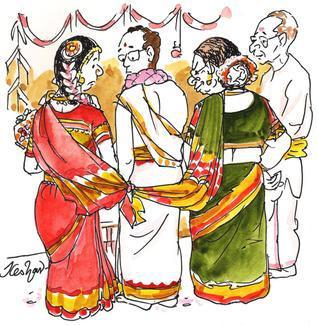I have always had this issue with many North Indians considering everybody living south of the Vindhya mountains (or in modern times, everyone south of Andhra Pradesh) as ‘Madrasis’. While most of them don’t use this term derogatorily, the fact remains that they are doing a great disservice to all of us down south.
There are just so many varieties of South Indians that clubbing them together into one large dark skinned group is wrong and speaks of narrow minded stereotyping at its worst.
With that prelude, here’s yet another guest post by favorite guest author and this time he deals with his experiences at a Tamil Brahmin wedding with a few words of advice for couples who are inter-racial (at least from a South Indian perspective). Given that he has more than decade of matrimonial experience and happiness speaking for him, his advice is sound.
==============

Image courtesy: The Hindu website
Tamil Brahmins (Tam-Brahms) are of two kinds – Iyers and Iyengars. Iyengars follow Vaishnavite traditions while Iyers are Saivites. Iyengars in-turn are sub-divided in Vadakalai and Thenkalai. Iyers in-turn are sub-divided into Vadama, Brahacharanam etc. While superficially they seem similar, there are significant differences in rituals that these sub-sects follow.
We are Vadakalai Iyengars and our relative’s daughter was marrying an Iyer boy. Both are MBA grads, cosmopolitan and now settled in well paying jobs in Mumbai. It was a love marriage that took all the trappings of an arranged marriage. That seems to be the trend these days. The young ones want it both ways – all the fun of being in love and then enjoying the luxury of a traditional wedding! Right from the way the bride’s sari is tied (madisaar kattu), the mantras recited, the number of namaskarams made, the kind of food served, there are differences between Iyers and Iyengars. It was a pity that right through the wedding ceremony these differences spilled out as disagreements & arguments between the bride and the groom’s parents & relatives. While I hope & pray that the young couple have a long, happy married life together, I have a sneaking feeling that their parents & relatives will not make it easy for them.
All our romantic movies end with a wedding scene. Life actually starts then. The sequel is not always so romantic. In an arranged marriage typically a support system kicks in to smoothly complete the wedding ceremonies and the wedding generally happens with the blessings of everyone. In a love turned-into arranged marriage, one side or the other would have agreed only reluctantly to the wedding and this generally shows in the cooperation (or lack of) that they extend during the ceremony. Some of these disputes (though minor in nature) turn into long standing grudges and come in the way of a happy marriage.
For those of you in love with a person from another community, my advice is to talk to your loved one about what ceremonies that you are going to go through much ahead of your wedding and get everyone’s consent. In Indian marriages, we don’t marry an individual. We ‘marry’ the individual’s family! Getting to know everyone in your loved one’s family will make life much easier for you.
I was pretty much a rolling stone and nobody (least of all me) thought I will be marriageable. It was an arranged marriage. What helped I think, was the 6 months gap we had between our engagement and the marriage. It gave us a chance to understand each other and know about each other’s families. Once we married, both our parents stepped away and let us lead our lives. Both my mother and mother-in-law turned out to be good friends and I think their relationship transcended the formality of their roles. It is now 13 years since we got married and I think we are doing OK. My wife & kids complain about my dressing, my spending habits, my weight and pretty much about everything. But, that is quite normal and on par!
